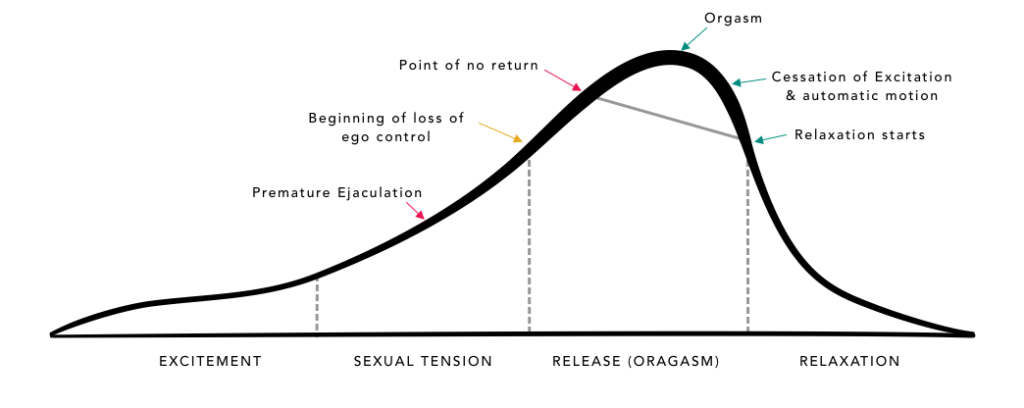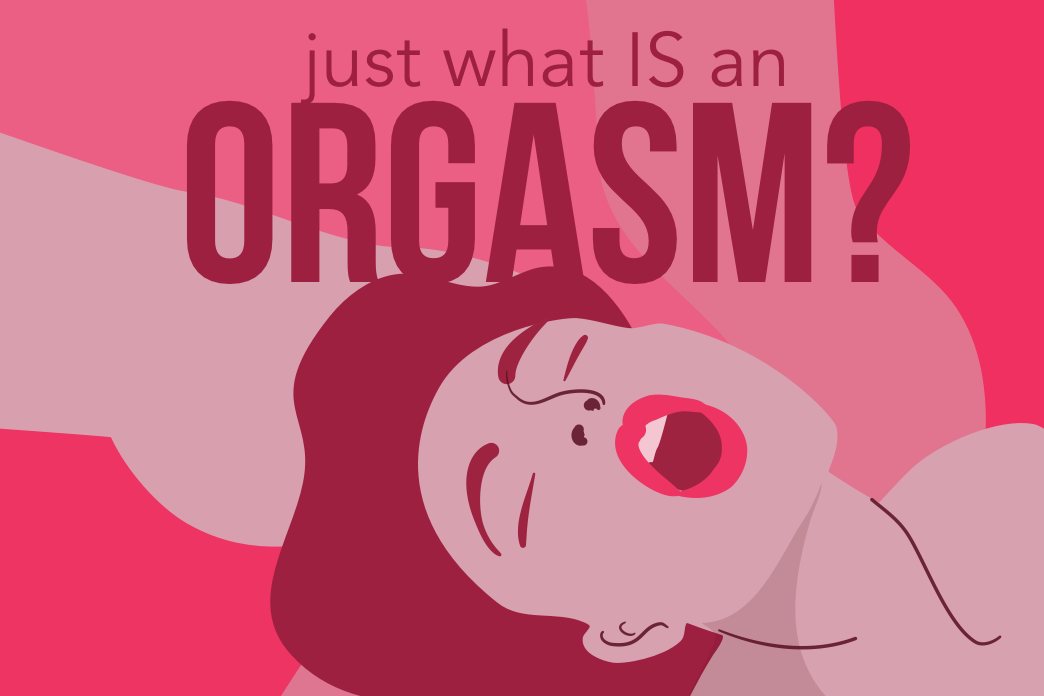
(Fun fact: This makes orgasm a metonymy, a figure of speech wherein a concept is referred to by something closely associated with it.) When I type ‘orgasm’ into Google, this is what comes up as a definition:
or·gasm
/ˈôrˌɡazəm/
noun
a climax of sexual excitement, characterized by feelings of pleasure centered in the genitals and (in men) experienced as an accompaniment to ejaculation.
Which is both a good place to start and definitely inaccurate—at least for many. Let’s break this down.
a climax of sexual excitement
So, climax is defined as “the most intense, exciting, or important point of something; a culmination or apex.”Which suggests that there is only one. THE CLIMAX. Which is great, if that’s how it goes for you. But it actually doesn’t cover the variety of orgasmic experiences and multiples.
characterized by feelings of pleasure centered in the genitals
Except not all orgasms are specifically centered in the genitals. Because genital is defined as “a person or animal’s external organs of reproduction,” even an orgasm from the anus would not qualify under this definition, nor would those from other areas like nipples, neck nibbles or those created solely in the mind.
and (in men) experienced as an accompaniment to ejaculation
Setting discussions about gender too deep to go into here, there are several potential issues with this part:
- Some men ejaculate, some don’t.
- Some non-men ejaculate, some don’t.
- Sometimes those that ejaculate with orgasms don’t.
- Sometimes those that ejaculate do so without full orgasm.
So, simply going by a textbook definition is actually going to give us an inaccurate picture of what orgasm is. Fuck. Don’t make it easy on me, eh? Ohhhh-kay.
What is an orgasm?
How to say it? There is no “standard orgasm.” Each orgasm depends on the individual’s capacity for pleasure and excitement.
And how would we compare that?
Why would we?
And wouldn’t that take the fun out of orgasms, anyway?
For example, both you and a friend get a paper cut on your index finger. You both hurt. Is it worth trying to gauge who hurts more? If so, how?
By how vocal or dramatic you are about it?
By who is more proud of their pain?
By who cries or doesn’t?
Orgasm is a subjective experience.
Orgasm as a release.
Freud first proposed the idea that pleasure results from the release of body tension. He related the degree of one’s pleasure to the amount of tension discharged. And he was right. Often, the greater your charge, the more rapid your release and the greater your pleasure.
(We talk more about “charging up” in my book on orgasms, Next Stop: O-Town, A roadmap to your orgasm and sexual release. May 2020)
Dr. Wilhelm Reich postulated that a person cannot be physically or emotionally healthy unless they experience frequent and complete orgasms. He defined orgasm as “the capacity for complete discharge of all dammed-up sexual excitation through involuntary pleasurable contractions of the body,” in his book. The Function of the Orgasm.
Also according to Dr. Reich, orgasms are necessary for our physical and emotional health.
Dr. Reich presented an orgasm theory related to the process of an orgasm, how it happens, and what stages lead up to it. Masters & Johnson took it further. With this knowledge you can potentially alter the quality of your orgasms.

Stage one, mechanical tension turns to a bioelectric charge (stage two), which then becomes stage three, a bioelectric discharge (orgasm), followed by mechanical relaxation (stage four).
Which sounds oh so fabulously boring, doesn’t it? What about, you get turned on/excited, and start to feel that delicious sexual tension, which builds and builds, then suddenly, you release it in a tidal wave of pleasure before it subsides, and your entire body relaxes and goes into rest mode.
Better?
Yeah, I think so.
So, excitement turns to sexual tension, which builds until it releases and your body relaxes.

excitement > sexual tension > release > relaxation
Don’t get me wrong. I’m not knocking Masters & Johnson. They did amazing things for human sexuality.
I’m just interested in both simplifying the idea with terms that are easier to use and in making it less specific to penetration/foreplay and a division between sex and sensuality for our puposes.
Excitement
This is where the mind’s attention has been caught. You may not yet be fully focused, but you’re definitely intrigued and excitement is growing.
If you have a penis, it is likely to begin to stir as blood starts to fill the vesicle, swelling it. Some will notice “pre-cum,” or a thick, colorless fluid beginning to seep out of their urethra. Some people might release a lot of this fluid, others may not even notice it, as not enough is released to escape fully.
If you have a vagina, your vaginal walls may begin to contract, causing a secretion of fluid that lubricates the vagina. Analogue to a penis, the clitoris will begin to fill with blood and swell.
All may find their nipples becoming harder and more erect, breathing quickening, skin flushing, and you may make involuntary sounds. Your body will likely become more sensitive to touch, overall.
Sexual Tension
Your attention is narrowing. Your mind is becoming hyper focused and anything other than your sexual feelings and pleasure could feel like it doesn’t exist or is receding.
If you have a penis, it is likely becoming more erect, even reaching maximum hardness in this stage. Your testes are flattening and rising towards the body. Seminal fluid is forming in the vesicle. This is the stage that awareness of imminent ejaculation happens.
If you have a vagina, the cavity is expanding, or ballooning. Contractions are increasing, creating more lubrication. Labia are experiencing additional blood flow, and are swelling and changing color. The flesh at the entrance to the vaginal canal is engorged with blood (making the nerve endings even more sensitive) and deepens in color to a darker red.
All will have increased heart rates and breathing. Your blood pressure will go up, and muscles will tense. Involuntary noises will increase in sound and frequency, and your skin may become both more flushed and even more sensitive to sensation.
Release
This is it! The big moment! For many, the logic centers of the brain will be shut off, or at least ignored in favor of sensation and pleasure. All focus will be aimed towards reaching this release.
If you have a penis, it is probably full to bursting, and the pressure of the blood filling it has increased sensitivity to a fever pitch. The penis is contracting in orgasm, usually at a rate of about once every eight-tenths of a second, setting off ejaculation. Your testicles have pulled up close to your body, and semen begins to flow upward, towards the mouth of the spinal vesicle. This is known as ejaculatory inevitability, since at this point the ejaculation cannot be stopped or controlled, and the semen pushes out of the tip of the penis.
If you have a vagina, your entire genital area is filled with blood and your vaginal walls are contracting, usually at a rate of about once every eight-tenths of a second. The clitoris is full of blood, enlarged and standing erect, and lubrication is generally increased.
All will be experiencing heavy breathing, hardened and erect nipples, involuntary sounds and elevated blood pressure. The sphincter will contract. Your eyes and mouth may open and close involuntarily in response to pleasure. Your skin will likely be flushed, possibly even over-sensitive and itchy, due to a rush of blood.
When your genitals cannot tolerate any increased blood flow and muscular tension is at its peak of endurance, your body will let go, and the blood will return to the rest of your body.
This fast release—the spasm of letting go, the total relaxation of all muscles, all tension, all pain—is the physical orgasm. You may feel any/all/some of these reactions.
You may feel things I’ve not thought to mention. If you do not experience the spasm of letting go and the instant release of tension, you’ve not experienced physical orgasm.
Which, as I’ve already noted, is NOT the only way to orgasm. It is the most commonly known and understood, and is worth exploring, if you have an interest. I talk about this physical release and the many ways to create it and experience it quite a lot in my book.
So, you orgasmed. You came.
As you’re panting in a state of nearly comatose pleasure for a few seconds or more, you are diving deep into the relaxation phase.
Relaxation
At this point, your body goes into reverse mode. Everything that was done to build toward release is now tidied up and put back where it came from.
All that blood that rushed to your genitals and skin surface returns to filling up other (important) parts of your body and your genitals lose their swelling and your skin color returns to normal.
Your brain returns back to your control, and your attention spreads again, picking up more of your surroundings.
Your breathing returns to normal.
Your body also now gets to deal with an amazing dump of feel-good chemicals.
If you have a penis, you are probably familiar with the refractory period, where you need to take some time to recover and begin building sexual tension again. It may be a few minutes or a few days. There is no one-size-fits all.
What is rarely discussed is that many people both with and without penises experience this refractory period, especially when they are used to single orgasm experiences. There are many reasons:
- Oxytocin increases feelings of satiation and contentment, and frankly, they just don’t WANT to get excited again.
- Orgasm can be hard, and fuck it, they’re tired.
- Orgasms can literally wring their muscles to the point that they can’t move, or moving is awkward for a period.
- They become super-sensitive, and trying again is painful.
- Some people get numb after orgasm, so what’s the point until that goes away?
- Some people are triggered to eat by orgasm, and there is no use in trying to interest them in something other than food.
- Sometimes the chemical dump sends them off to sleep like a sweet angel—until he next time.
And so on.
Luckily, any gender can learn to enjoy multiple orgasms (IF they want to), and I talk more about multiple orgasms in my book.
Let’s go with all this this as an out-of the box solution for “what is an orgasm?” shall we?
Does that mean that YOUR orgasm, if mapped out would look and feel like that?
Or that your foreplay might take up that tiny bit at the front, and then penetration is going to take you “there?”
Or that you’ll get that high, or ONLY that high?
Nope. None of the above.
And so, In the book, we look at other patterns of orgasm.
For example, like this one:

In multiple orgasms, plateau is reached, and orgasm, but it’s not enough to fully release the charge, so it builds more, releases a bit and build more, and so on.
The key is to use this theory as a visualization tool for our own orgasmic experiences and how we might want to explore new variations.









2 Responses
Loved this content. Was looking for your book but couldn’t find it.
@Eboni Hanewald
Hello! Thanks for stopping by! Glad to hear you enjoyed this post by Nookie.
Regarding her book on orgasms (O-Town: A Road Map to Your Sexual Release), you can find the book at the link below:
https://datingkinky.com/books/otown/
I have also added a hyperlink to it in this post (in the “Orgasm as a release” section).